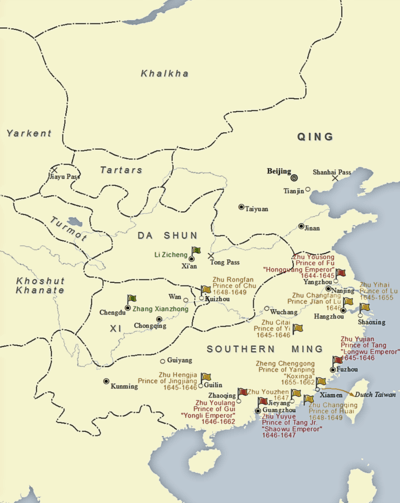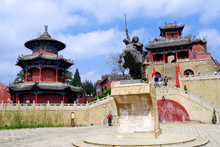Li Zicheng
| Li Zicheng | |||||||||
|---|---|---|---|---|---|---|---|---|---|
| Emperor of the Shun Dynasty | |||||||||
| Reign | 1644-1645 | ||||||||
| Born |
22 September 1606 Li Jiqian village, Yan'an prefecture, northeast Shaanxi | ||||||||
| Died | 1645 (aged 38–39) | ||||||||
| |||||||||
| Dynasty | Shun dynasty | ||||||||
| Li Zicheng | |||||||||
| Chinese | 李自成 | ||||||||
|---|---|---|---|---|---|---|---|---|---|
| |||||||||
| Li Hongji | |||||||||
| Traditional Chinese | 李鴻基 | ||||||||
| Simplified Chinese | 李鸿基 | ||||||||
| |||||||||
| "Dashing King" | |||||||||
| Traditional Chinese | 闖王 | ||||||||
| Simplified Chinese | 闯王 | ||||||||
| |||||||||
Li Zicheng (22 September 1606 – 1645), born Li Hongji, also known by the nickname, "Dashing King",[1] was a Chinese rebel leader who overthrew the Ming dynasty in 1644 and ruled over northern China briefly as the emperor of the short-lived Shun dynasty before his death a year later.
Early years
Born in 1606 as Li Hongji to an impoverished family; Li Zicheng came from Li Jiqian village, Yan'an prefecture, northeast Shaanxi province. Li came from a family of farmers and had an older brother who was 20 years older than him whose son, Li Guo, grew up alongside Li. Li was literate though it is disputed from where Li attained his education. While a teenager and as a young adult Li held jobs in a wineshop, a blacksmith's shop, a farm, and also as a mailman in the state courier system.
According to folklore, in 1630, Li was put on public display in an iron collar and shackles for his failure to repay loans to a usurious magistrate, Ai. Ai struck a guard who offered shade and water to Li, whence a group of peasants friendly to Li tore apart Li's shackles, spirited him to a nearby hill, and proclaimed him their leader. Although they were only armed with wooden sticks, Li and his band managed to ambush a group of government soldiers sent to arrest them, and obtained their first real weapons.[1]
Rise of Li Zicheng and the peasant rebellions
The late Ming Dynasty considerably weakened as the government struggled with finances and these economical issues as well as environmental problems and sickness plagued China.[2] Sicknesses included smallpox and possibly the black plague. In 1639 An extreme epidemic hit the Yangzi region and as it spread across the north, it became known as the Chongzhen Slough. The hardships from the environment and resulting toll on the Ming subjects led to major peasant uprisings in Northern China, namely from the Shaanxi province.[2] The northern areas of China experienced famine first due to the failure of the Chongzhen government to fix the financial issues and provide aid to the northern areas suffering from famine and sickness.[2] Once the drought hit the Shaanxi province in 1628, this spurred the first rebellions. Li Zicheng and Zhang Xianzhong (also from Shaanxi province) were two of the major leaders in the peasant rebellions under the late Ming dynasty.
Li joined a rebel army led by Gao Yingxiang who was nicknamed "Dashing King". in 1633. He inherited Gao's nickname and command of the rebel army after Gao's death.[1]
Within three years, Li succeeded in rallying more than 30,000 men to form a rebel army. They attacked and killed prominent government officials, such as Sun Chuanting, in Henan, Shanxi and Shaanxi provinces. As Li won more battles and gained more support, his army grew larger. People attributed that the rebel armies were kind to the poor and that they would only attack Ming officials.[1]
Some battles Li fought in this period
- Battle of Chexiang Pass
- Battle of Fengyang
Battles of Luoyang, Nanyang and Kaifeng
Li advocated the slogan of "dividing land equally and abolishing the grain taxes payment system" which won great support from the peasants. The song of "killing cattle and sheep, preparing tasty wine and opening the city gate to welcome the Dashing King" was widely spread at that time.
The 1642 Kaifeng flood (during the 3rd Battle of Kaifeng), caused by breaches of the Yellow River dikes by both sides,[3] ended the siege of Kaifeng and killed over 300,000 of its 378,000 residents.[4] After the battles of Luoyang and Kaifeng, the Ming government was unable to stop Li's rebellion, as most of its military force was involved in the battle against the Manchus in the north. Li declared himself the King of the Shun dynasty in Xi'an, Shaanxi.
From the Battle of Xiangyang to the creation of the Shun dynasty
In 1642, Li captured Xiangyang and proclaimed himself "King Xinshun".

Battle of Beijing and establishment of the Shun Dynasty
Li Zicheng led one of the major peasant uprisings that the weakened Ming administration struggled to combat. When Li took over the Ming capital it marked the end of the Ming dynasty. In April 1644, Li's rebels sacked the Ming capital of Beijing, and the Chongzhen Emperor committed suicide. Li proclaimed himself the Emperor of the Shun dynasty.
Claim to the Mandate of Heaven
Li, as all contenders for the throne were required, claimed to have the Mandate of Heaven bestowed upon him. Firstly, Li hailed from the Shaanxi province of China, which strengthened his legitimacy to the throne versus the foreign Manchus. Li also gained the support of scholar officials which was important in leading over the people of China as a Confucian state. The name of the dynasty is translated to mean "Obedient to Heaven".[5]
Battle of Shanhai Pass and end of Shun Dynasty
Li's army was defeated on 27 May 1644 at the Battle of Shanhai Pass by the combined forces of the defecting Ming general Wu Sangui and the Dorgon Prince leading the Manchus. The Ming and Manchu forces captured Beijing on June 6 and Fulin ascended to the throne to establish the Shunzhi reign with the Dorgon prince as regent.[5]
Death
When Wu Sangui and the Dorgon Prince took control of Beijing, Li fled to Xi'an[6] in Shaanxi. It is not exactly known how Li died and there are multiple accounts of his death which vary and some are exaggerated by folklore. Across multiple sources, the year of his death is said to be in 1645. One account states that in the summer of 1645 Li went to raid a village in search of sustenance with his remaining followers and was killed by soldiers guarding the village.[6]
Historiography

Although the success of the Manchu conquest of China was attributed to the weakening of the Ming dynasty (exacerbated by Li Zicheng's rebellion), official historiography during the Qing dynasty regarded Li as an illegitimate usurper and outlaw. This view sought to discourage and demonize notions of rebellion against the Qing government, by propagating that the Manchus put an end to Li's illegitimate rule and restore peace to the empire, thus receiving the Mandate of Heaven to rule China.
In popular culture
Li appears as a bandit in Baifa Monü Zhuan, a wuxia novel by Liang Yusheng, where the heroine comments he is worthy of being a king. Li is featured as a character in some of the works of Hong Kong wuxia writer Jin Yong (Louis Cha). Li's rebellion against the Ming dynasty is featured in Sword Stained with Royal Blood and his personality is analysed from the point of view of Yuan Chengzhi, the protagonist. In The Deer and the Cauldron, set in the Qing dynasty during the early reign of the Kangxi Emperor, Li is revealed to have survived and fathered a daughter, A'ke, with Chen Yuanyuan. Li is also briefly mentioned by name in Fox Volant of the Snowy Mountain and The Young Flying Fox.
Li is the main character of the historical epic novel Li Zicheng by Yao Xueyin.[7]
In folklore
There are many stories and folklore attributed to Li Zicheng. One such story claims that when Li Zicheng was young he killed one of his classmates and was promptly disowned by his family and shunned by his community.[2]
References
- 1 2 3 4 Des Forges, Roger V. (2003). Cultural Centrality and Political Change in Chinese History : Northeast Henan in the Fall of the Ming. Stanford, California: Stanford University Press. pp. 206, 209. ISBN 0-8047-4044-5.
- 1 2 3 4 Brook, Timothy (2010). The Troubled Empire : China in the Yuan and Ming Dynasties. USA: The Belknap Press of Harvard University Press. pp. 249–253. ISBN 978-0-674-04602-3.
- ↑ Lorge, Peter Allan War, Politics and Society in Early Modern China, 900–1795 Routledge; 1 edition (27 Oct 2005) ISBN 978-0-415-31691-0 p.147
- ↑ Xu, Xin The Jews of Kaifeng, China: history, culture, and religion Ktav Pub Inc (Feb 2003) ISBN 978-0-88125-791-5 p.47
- 1 2 Porter, Jonathan (2016). Imperial China : 1350-1900. USA: Rowman & Littlefield. pp. 119–121. ISBN 9781442222939.
- 1 2 Rowe, William T. (2009). China's Last Empire : The Great Qing. USA: First Harvard University Press. p. 19. ISBN 978-0-674-03612-3.
- ↑ Martinsen, Joel (17 January 2008). "A tragic peasant rebellion, abridged for today's readers". Danwei.
External links
"Dashing King" Born: 22 September 1606 Died: 1645 | ||
| Regnal titles | ||
|---|---|---|
| Preceded by Chongzhen Emperor of Ming |
Emperor of China Shun dynasty 1643–1645 |
Succeeded by Shunzhi Emperor of Qing |